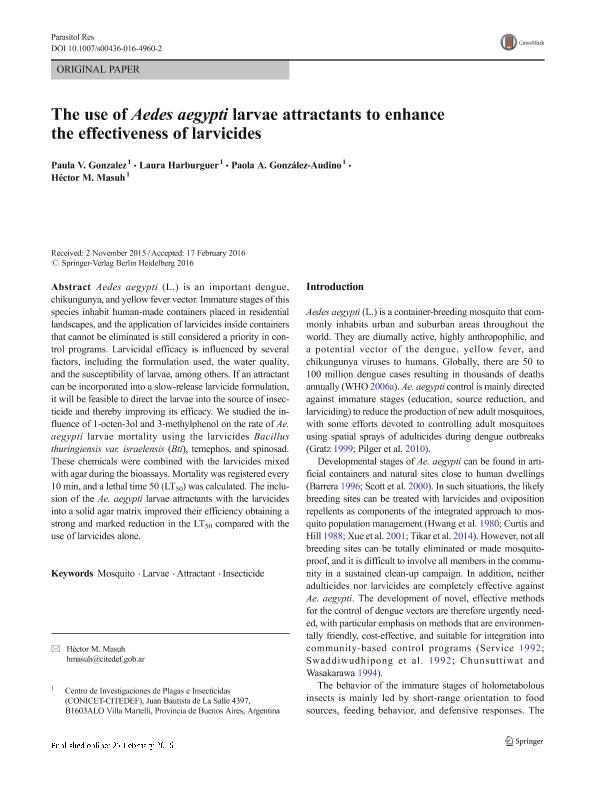Artículo
The use of Aedes aegypti larvae attractants to enhance the effectiveness of larvicides
Gonzalez, Paula Valeria ; Harburguer, Laura Vanes; Gonzalez Audino, Paola Andrea
; Harburguer, Laura Vanes; Gonzalez Audino, Paola Andrea ; Masuh, Hector Mario
; Masuh, Hector Mario
 ; Harburguer, Laura Vanes; Gonzalez Audino, Paola Andrea
; Harburguer, Laura Vanes; Gonzalez Audino, Paola Andrea ; Masuh, Hector Mario
; Masuh, Hector Mario
Fecha de publicación:
02/2016
Editorial:
Springer
Revista:
Parasitology Research
ISSN:
0932-0113
Idioma:
Inglés
Tipo de recurso:
Artículo publicado
Clasificación temática:
Resumen
Aedes aegypti (L.) is an important dengue, chikungunya,and yellow fever vector.Immature stages of this species inhabit human-made containers placed in residential landscapes, and the application of larvicides inside containers that cannot be eliminated is still considered a priority in control programs. Larvicidal efficacy is influenced by several factors, including the formulation used, the water quality, and the susceptibility of larvae, among others. If an attractant can be incorporated into a slow-release larvicide formulation, it will be feasible to direct the larvae into the source of insecticide and thereby improving its efficacy. We studied the influence of 1-octen-3ol and 3-methylphenol on the rate of Ae. aegypti larvae mortality using the larvicides Bacillus thuringiensis var. israelensis (Bti), temephos, and spinosad. These chemicals were combined with the larvicides mixed with agar during the bioassays. Mortality was registered every 10 min,and a lethal time 50 (LT50) was calculated. The inclusion of the Ae. aegypti larvae attractants with the larvicides into a solid agar matrix improved their efficiency obtaining a strong and marked reduction in the LT50 compared with the use of larvicides alone.
Palabras clave:
MOSQUITO
,
LARVAE
,
ATTRACTANT
,
INSECTICIDE
Archivos asociados
Licencia
Identificadores
Colecciones
Articulos(UNIDEF)
Articulos de UNIDAD DE INVESTIGACION Y DESARROLLO ESTRATEGICOS PARA LA DEFENSA
Articulos de UNIDAD DE INVESTIGACION Y DESARROLLO ESTRATEGICOS PARA LA DEFENSA
Citación
Gonzalez, Paula Valeria; Harburguer, Laura Vanes; Gonzalez Audino, Paola Andrea; Masuh, Hector Mario; The use of Aedes aegypti larvae attractants to enhance the effectiveness of larvicides; Springer; Parasitology Research; 115; 6; 2-2016; 2185-2190
Compartir
Altmétricas



